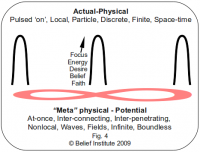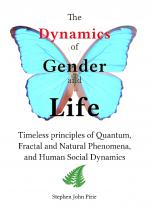The Art and Science of Blinking
Around 2,450 years ago the ancient Greek philosopher Zeno of Elea was perhaps the first to methodically question a simple fact of life - how do we physically move, such as when blinking an eye, running, or simply falling down?
A simple question by Stephen: If I move a finger 1cm, science says -- by way of using calculus (infinite-series) to calculate its movement-- that it goes through infinite contiguous little steps producing smooth movement, like a motion-picture film.
What bodily processes (electrical, chemical, neurological) begins, maintains and stops that infinite PHYSICAL-step movement?
He reasoned that (if life is like a motion picture film, with individual frames of movement), we would need to "flick through" an endless number of them, assuming physical movement to be "perfectly continuous."
Throughout the intervening 2,400 plus years this simple consideration has vexed philosophers and scientists. In order to resolve this dilemma the mathematics of continuity known as 'calculus' was developed and perfected to show that in theory, infinite movements could be accomplished in a fixed and finite amount of time - thus accommodating and explaining the everyday physical movement of walking from point A to B in so many seconds, minutes and so forth.
With calculus came Newton's Laws of Motion, which in turn helped jump-start the industrial revolution. Not only were Zeno's troubling paradoxes solved, but we also got the wonderful benefit of our modern industries, technologies and convenience.
All good, it would seem—a double-deluxe of solving an age-old dilemma while enabling new time-saving and life-saving technologies and sciences.
But for some, or perhaps for many, including some leading thinkers and physicists, the question remained "Do we really need to 'flick through' an endless, never-ending number of frames of movement, every time we blink or breathe?" If we assume "perfect continuity" of movement, doesn't that imply impossibility of any of us initiating physical movement?
Some began to wonder, if our sciences and technologies are based on this calculus, which require in theory our jumping through endless hoops, are we missing something vitally important? Is our world just one big clock-work machine? Where does spirit, love and mystery fit into the picture?
Does it make sense that life involves having to wade through an endless sea of numbers, names and notions (with every frame amid countless others necessarily having a uniquely counted identity, description and substance)?
Enter the quantum era
During the early stages of the 20th century, certain physical facts1 began to emerge that couldn't be accommodated by the mathematics of continuity. Newton's Laws of Motion no longer worked to explain the facts. It wasn't that Newton's Laws or calculus were wrong, they simply couldn't be directly applied to fit the physical evidence.
Just as the 'earth' (floor) maybe be flat in our lounge-rooms, while being something more than flat for the whole planet, Newton's calculus worked for big things, while something more was required to explain the minutia of life.
That something more was quantum theory – a new science that is now recognised as being by far the most successful physical theory in history.
One of the key results of quantum theory was to show that the "something more" needed to explain our world is meta-physical in nature. This "meta" aspect is literal, and ubiquitous in life. Quantum physics reveals that there are aspects to our lives that not only will remain beyond direct physical observation, measurement and explanation2, but that the "something more" is happening well beyond the speed of light – it is happening instantly, ubiquitously, across all space, and according to recent research, across time.
Quantum research has now thoroughly verified the fact of nonlocality—an at-once interconnectedness that is necessary to the functioning and operation of our physical system.
This at-once interconnectedness—essential for any complex system, body, or ecosystem to function—is tantalizingly glimpsed through quantum research and experiment, but necessarily remains beyond simplistic and expedient categorisation and description.
Clicking into place
With the experimental results of quantum physics we can now form an integrated world-view, one that combines science, religion and all aspects of personal, social and spiritual experience.
We may do this by combining the facts, as observed in the field of quantum physics, and allowing them to form a template of understanding that scales upwards and outwards into all aspects of personal, social and physical experience.
Primarily, we begin by revisiting Zeno's queries, recognising that in our physical system, "according to the quantum theory, movement is not fundamentally continuous"3—the world we experience is like a motion picture film that has been, and is projected and solidified into 3 dimensions, "with the individual frames going by extremely fast"4 such that, like a motion picture film, it "is flickering on and off every 5.3 x 10-44 seconds".5 Instead of an endless, never-ending series of steps when we blink or breathe, we take a large, but finite number of quantum-scaled jumps.
With this understanding, we may start to meld together seemingly disparate phenomena.
If our universe is being projected into physically, we can quickly and easily recognise the projective mechanism by reviewing the process of how we each achieve results in life.
We can recognise that it is initially our intent that builds sufficient electrical potential to fire the neurons in our brains, for us to "think" thoughts.
Thus, the projecting mechanism in nature, and in our lives, is driven by rising potentials of intent, which helps us to fire the neurons, enabling us to choose and create the discrete thoughts, ideas and results we achieve and experience.
The new era of quantum mind-science
Recognising the at-once nature to life, and that all is interconnected, yields insights into the causes of all phenomena. Primarily, we live within, and help create an exceptionally complex, but nonetheless self-organising system, one that is self-organising with intent.
Taking a self-organising systems view allows us to recognise that evolution occurs with intent, towards development and fulfillment of each species and the entire ecosystem. However, just as cells die to serve the body, some species will become extinct, while new ones will emerge into our reality to serve the intent of our bodies, communities and the whole ecosystem.
Where this has significance is understanding that nature will respond in ways to serve the overall ecosystem, and that new viruses, for example, will emerge into reality to assist that intent. The expectation that we can inoculate ourselves against, or kill emergent viruses and related biological phenomena that are working to balance the ecosystem, is both short-sighted and ultimately works towards the emergence of stronger and more virulent viruses.
We cannot expect to second-guess the myriad possibilities that are building as a result of the deeper intent of individuals, collectives and the global ecosystem.
We cannot expect that treating the biological system as a merely a complex machine, will yield sustainable or productive results in the long-term.
What "clicks into place" is our responsibility, and it is our responsibility to encourage and create a vibrant, expansive and viable reality.
See also
- Zeno's Paradoxes (section, this website)
- Proof of the impossibility of physical movement
- The modern superstitions of science and religion
- 1. Referring here to the 'Atomic Catastrophe', and the 'Ultra-violet Catastrophe' dilemmas faced when attempting to apply classical Newtonian physics on atomic and subatomic scales - see Congruent Solutions to Zeno's Paradoxes
- 2. Meaning we cannot entirely reduce physical phenomena to physical causes
- 3. David Bohm, Wholeness and the Implicate Order (Emphasis by Stephen, Italics by Bohm)
- 4. Norman Friedman, The Hidden Domain: Home of the Quantum Wave Function, Nature’s Creative Source, The Woodbridge Group, Eugene OR 1997, p. 165.
- 5. Freidman, p. 164.
 "The Dynamics of Gender and Life" ebook is now available at
"The Dynamics of Gender and Life" ebook is now available at